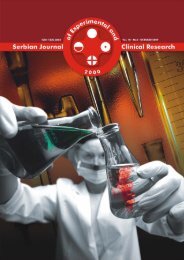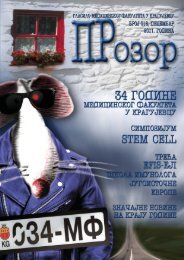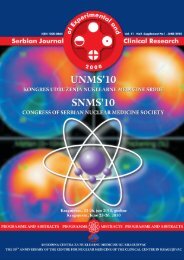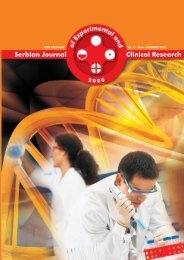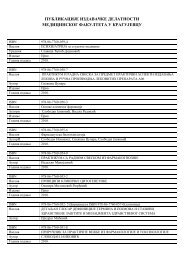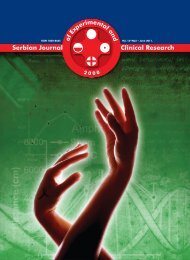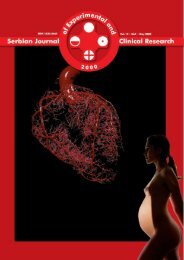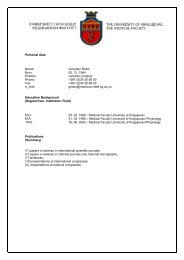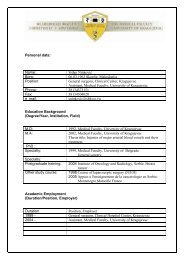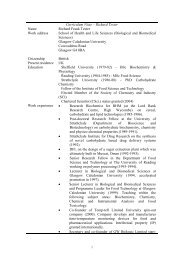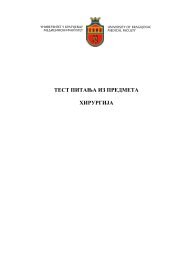ORIGINAL ARTICLE ORIGINALNI NAUČNI RAD ORIGINAL ARTICLE ORIGINALNI NAUČNI RADEXPERIMENTAL MODELS OFDIABETES MELLITUSJelena Pantic 1 , Vladislav Volarevic 1 , Aleks<strong>and</strong>ar Djukic 11Faculty <strong>of</strong> Medicine, University <strong>of</strong> KragujevacEKSPERIMENTALNI MODELIDIJABETES MELITUSAJelena Pantić 1 , Vladislav Volarević 1 , Aleks<strong>and</strong>ar Đukić 11Medicinski fakultet, Univerzitet u KragujevcuReceived / Primljen: 27. 07. 2010. Accepted / Prihvaćen: 03. 03. 2011.APSTRAKTEarly studies on pancreatectomised dogs confirmed thecentral role <strong>of</strong> the pancreas in the homeostasis <strong>of</strong> glycemia <strong>and</strong>resulted in the discovery <strong>of</strong> insulin. Today, hundreds <strong>of</strong> differentanimal models are used in experimental studies <strong>of</strong> diabetes. Theaim <strong>of</strong> this review is to present experimental models <strong>of</strong> type 1<strong>and</strong> type 2 diabetes. In preparing for this review, we searched theelectronic databases Medline, Highwire, <strong>and</strong> Hinari.The majority <strong>of</strong> the experiments are conducted on rodentmodels (mice <strong>and</strong> rats). Selective inbreeding resulted in the development<strong>of</strong> numerous models with pathogenic characteristics <strong>and</strong>the manifestation <strong>of</strong> type 1 <strong>and</strong> 2 diabetes <strong>and</strong> the related phenotypes<strong>of</strong> obesity <strong>and</strong> insulin resistance. In addition to analyzingthe pathogenic <strong>mechanisms</strong> <strong>of</strong> the disease <strong>and</strong> its complications,these models are used to evaluate new treatment solutions as wellas the transplantation <strong>of</strong> beta cells <strong>and</strong> disease prevention. Newanimal models have been created using techniques based in molecularbiology <strong>and</strong> genetic engineering: transgenic, knockout <strong>and</strong>tissue-specific knockout models. These are very powerful methods,which may lead to exciting results in the future.Key words: animal models, experimental diabetes, mouse, ratSAŽETAKPrve studije rađene na psima kojima je prethodno uklonjenpankreas potvrdile su centralnu ulogu pankreasa uhomeostazi glikemije i doprineli otkriću insulina. Danas,veliki broj različitih eksperimentalnih modela se koristi uistraživanjima u oblasti dijabetesa. Cilj ovog revijskog radaje da predstavi neke od ovih modela, koristeći kao literaturuoriginalne i revijske radove elektronskih baza Medline,Highwire i Hinari.Većina laboratorija koristi selektivnim inbridingom dobijenemiševe i pacove, kao i transgene i nokaut životinje dobijenegenetskim inženjeringom, koje zbog svojih karakteristika(npr. gojaznost, rezistencija na insulin) predstavljaju idealneeksperimentalne modele za dijabetes tip 1 ili 2. Ovi eksperimentalnimodeli koriste se kako za ispitivanje patogenezedijabetesa tako i za ispitivanja novih terapijskih sredstava ulečenju šećerne bolesti.Ključne reči: animalni modeli, eksperimentalni dijabetes,miš, pacovUDK 616.379-008.64 / Ser J Exp Clin Res 2011; 12 (1): 29-35Correspondence to: Jelena Pantic, Address: Janka Veselinovica 3/3, 11000 BeogradTel: 064/1550001, 011/3861942, E-mail: panticjelena@open.telekom.rs29
INTRODUCTIONSince 1880, when von Mering <strong>and</strong> Minkowski removedthe pancreas from a dog displaying symptoms <strong>of</strong> diabetesmellitus (1), many experiments have been conducted onmice, rats, rabbits, <strong>and</strong> dogs, which were all used as experimentalmodels for this disease.The rodents (mice <strong>and</strong> rats) are most frequently usedin laboratory research <strong>of</strong> type 1 <strong>and</strong> type 2 diabetes becausethey are biologically <strong>and</strong> genetically similar to people,their reproductive potential is high, their life spanis short, <strong>and</strong> they are cheap <strong>and</strong> easy to h<strong>and</strong>le (1). Themain drawback <strong>of</strong> these models is that sometimes theyare unable to successfully simulate pathological processesoccurring in humans; in those situations, the use <strong>of</strong> cats,dogs, pigs or primates is justifiable.Models <strong>of</strong> experimental diabetes are:1. <strong>induced</strong> (experimental)2. spontaneous (genetically <strong>induced</strong>) or3. transgenic <strong>and</strong> knock-out models (resulting from geneticengineering).Hyperglycemia is <strong>induced</strong> by:1. surgical method (partial or total pancreatectomy)2. non-surgical method (using a diabetogenic toxin in experimentalanimals) (Table 1) (2).MATERIALS AND METHODSWe searched the electronic databases Medline, Highwire,<strong>and</strong> Hinari. Selected papers, both original <strong>and</strong> review,have been summarized <strong>and</strong> cited with regard to theirscientific relevance for this research field.EXPERIMENTAL MODELS OFTYPE 1 DIABETES MELLITUSA) Induced modelsMultiple low-dose streptozotocin-<strong>induced</strong> diabetesStreptozotocin (STZ) is a derivative <strong>of</strong> nitrosoureathat has been isolated from Streptomyces achromogenes.It is a strong alkylating agent that affects glucose trans-ToxinDiabetogenic effectStreptozotocin Hyperglycemia, glucose intoleranceAlloxanHyperglycemia, glucose intoleranceChlorozotocin Hyperglycemia, glucose intoleranceDithizone Hyperglycemia, glucose intoleranceVacorHyperglycemiaOxineHyperglycemiaMethylnitrosurea Glucose intoleranceCyproheptadine Glucose intoleranceTable 1. Toxins with diabetogenic effectport (the role <strong>of</strong> glucokinase) <strong>and</strong> induces numerous lesionsin the beta-cell DNA chain (3-5). It can selectivelybind to glucose-transport protein 2 (GLUT2), which ispredominantly expressed on the membranes <strong>of</strong> pancreaticbeta-cells (3).Toxicity <strong>of</strong> the streptozotocin on beta-cells is complex<strong>and</strong> includes genetic <strong>and</strong> non-genetic <strong>mechanisms</strong> (6). Nitricoxide (NO) <strong>and</strong> other free radicals influenced by streptozotocinresult in spontaneous lesions <strong>of</strong> the DNA chain(7). Damaged DNA chains activate poly-(ADP-ribose)polymerase (PARP) as a reparatory mechanism, which incase <strong>of</strong> over-activation may have proapoptotic effects (8).PARP knockout mice were shown to be resistant for streptozotocin-<strong>induced</strong>diabetes (8).In addition, the toxicity <strong>of</strong> streptozotocin is associatedwith a drastic decrease <strong>of</strong> insulin reserves within beta cells,resulting from the fast catabolism <strong>of</strong> nicotinamide-adenine-dinucleotide+(NAD+), a substrate for PARP activation(9). Decrease <strong>of</strong> NAD+ <strong>and</strong> ATP+ provokes significantdepletion <strong>of</strong> insulin secretion as well as other basic processesinside the cell. While excessive activation <strong>of</strong> PARPrepresents a proapoptotic stimulus, the reduction <strong>of</strong> necessarycell energy results in cellular necrotic death.A single high dose <strong>of</strong> streptozotocin provokes diabetesin rodents, possibly as a result <strong>of</strong> the direct toxic effect.Multiple low-dose streptozotocin-<strong>induced</strong> diabetes (whenstreptozotocin is administered in lower doses (40 mg/kg)during five consecutive days) is an experimental model<strong>of</strong> type 1 diabetes <strong>and</strong> immune-mediated insulitis <strong>and</strong> iswidely used for studying the immunological background<strong>of</strong> this disease (10).Partial pancreatectomyThe partially pancreatectomised rat was one <strong>of</strong> the firstexperimental models <strong>of</strong> diabetes (11). The surgical removal<strong>of</strong> 90% <strong>of</strong> the pancreatic tissue resulted in a slow development<strong>of</strong> hyperglycemia over the course <strong>of</strong> 12 weeks to 20months (12). The period <strong>of</strong> post-surgical euglycemia is followedby the development <strong>of</strong> chronic hyperglycemia as aconsequence <strong>of</strong> a further failure <strong>of</strong> the remaining beta cells.The first stage <strong>of</strong> disease refers to glucose intolerancefollowed by a compensatory hyper-function <strong>of</strong> beta-cells,the exhaustion <strong>of</strong> the remaining beta cells <strong>and</strong> their furtherbreakdown 14 weeks after surgery (12). Altered beta cellgene expression is associated with a decreased production<strong>of</strong> islet amylin polypeptide (IAPP), transcription factors,ionic canals <strong>and</strong> pumps, including GLUT2, glucokinase,mitochondrial glycerophosphate dehydrogenase (mGPD)<strong>and</strong> pyruvate carboxylase (13). A reduction <strong>of</strong> insulin secretionfollows even in conditions <strong>of</strong> high concentrations<strong>of</strong> glucose <strong>and</strong> even after application <strong>of</strong> insulin secretagogues(14).Histopathological findings demonstrate hypertrophy<strong>and</strong> fibrosis <strong>of</strong> pancreatic islets related to the level <strong>of</strong> hyperglycemia(13). Insulitis, demonstrated as the infiltration<strong>of</strong> inflammatory cells, may be depressed, thus slowingdown the process <strong>of</strong> cell degeneration (15).30



